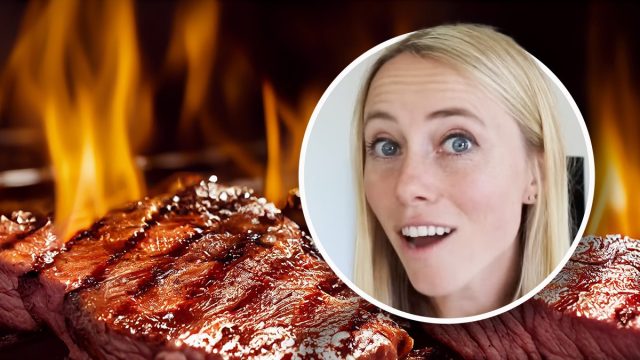17 Foods a Clinical Nutritionist Buys Weekly for Maximum Energy

Standing in the grocery store aisle, overwhelmed by choices? You're not alone. Clinical nutritionist Autumn Bates, who lost 20 pounds postpartum using these exact strategies, shares her proven weekly shopping list that helped transform her health and energy levels. These 17 nutrient-dense foods form the foundation of her approach to sustainable weight management and overall wellness. By stocking your kitchen with these essentials, you'll be equipped to create satisfying, healthy meals that support your weight loss goals while maintaining steady energy throughout the day.
Your Foundation Foods for Weight Management
"I specifically choose whole milk because it's higher in vitamin K2, which is crucial for heart and bone health," Autumn says in her post. She recommends grass-fed options like Alexander A2 milk for its regenerative farming practices and superior nutrient profile. Along with milk, she includes full-fat skyr or cottage cheese, noting their high protein content is perfect for maintaining satiety during weight loss.
Lean Proteins That Support Fat Loss
Whole chicken serves as a primary protein source in Autumn's weekly menu. "I like getting a whole chicken and roasting it up. This helps prevent it from getting dry and is substantially less expensive," she explains. "Cooked with the skin and bone on, it helps release some of the collagen into the chicken," she adds, maximizing both nutrition and satisfaction.
RELATED: 8 High-Protein Foods with Nearly Zero Calories That Melt Fat
.
The Weight Loss Breakfast Essential
Eggs are non-negotiable in Autumn's weight management strategy. "Eggs are so rich in choline, which is so important for memory and brain health," she shares. Going through 3-4 dozen weekly, she emphasizes their role in her morning routine: "Most mornings, my breakfast has been scrambled eggs, which helps keep me full and focused."
Smart Carbs for Steady Energy
"I recently started to eat a little bit more bread and I had my mind changed fairly recently about bread," Autumn reveals. She alternates between Ezekiel bread and traditional sourdough, explaining, "Ezekiel bread is sprouted and has a combination of different legumes as well as grains, so you get actually a more complete protein source," which helps maintain stable blood sugar levels.
Blood Sugar Balancing Fruits
Berries play a crucial role in Autumn's weight loss strategy. "They tend to be higher in fiber and low glycemic load, which means they're not going to really spike the blood sugar level," she explains. This makes them perfect for satisfying sweet cravings without derailing progress.
Strategic Banana Usage
"We're not eating bananas just like on their own. We're eating it in combination with other protein, fat and fibers, which helps to really stabilize the blood sugar response," Autumn explains, highlighting how proper food combining supports weight management.
Healthy Fats for Lasting Satiety
"We don't use nut butters as a form of protein. We purely use it for a high quality source of fat," Autumn explains about her weekly peanut or almond butter purchases. She adds, "I do find it a great way to boost the fat content of the meal and help to prevent cravings later on."
The Gut-Health Game Changer
"It provides not only the minerals, but also the collagen that my body really desperately needs," Autumn says about her weekly bone broth purchase. This supports gut health, which she emphasizes is crucial for successful weight management.
RELATED: 20 Things You Need to Know About Ozempic and Weight Loss
Smart Coffee Strategy
"I made the switch over to the one-third caffeinated coffee," Autumn shares, noting how better sleep quality supports her weight management goals: "Because the caffeine is so low, I'm not having any troubles falling asleep at night."
Digestive Support for Better Results
Fresh ginger is a weekly essential in Autumn's weight loss toolkit. "The ginger helps stimulate the migrating motor complex, which helps to flush out left behind food and bacteria that normally causes bloating," she explains.
Fiber-Rich Fat Sources
Avocados serve as a primary healthy fat source. "It's actually surprisingly rich in fiber," she notes, making it perfect for maintaining fullness while supporting weight loss goals.
Plant-Based Milk Alternative
Unsweetened almond milk serves as a versatile base for protein smoothies and chia puddings. "Keeping things simple for myself so that I can still have high quality home cooked meals, but not overwhelm myself," Autumn explains.
Greens for Nutrient Density
"I like buying frozen over fresh most of the time because frozen is pre-cooked and then frozen, which means that it helps to break down some of those anti-nutrients," Autumn explains about her spinach and kale purchases, making these nutrient-dense foods more bioavailable.
Cruciferous Vegetables for Success
A rotation of cauliflower, Brussels sprouts, and broccoli provides filling fiber and essential nutrients. "So tasty. Also, my daughter Sage loves it," she shares about her simple roasted cauliflower preparation.
Versatile Pantry Staples
Canned pumpkin and coconut provide convenience without compromising nutrition. "Each has different benefits," she explains, using them to add creaminess and nutrients to various dishes.
RELATED: 7 Simple Daily Exercises To Shrink Hanging Belly Fat
The Protein Powder Secre
"I specifically developed my protein powder to actually taste great in recipes," Autumn shares about her final weekly essential. This helps her maintain adequate protein intake while satisfying sweet cravings, supporting her successful 20-pound postpartum weight loss. And if you enjoyed this article, take advantage of these 15 Quick Ways to Lose Body Fat Percentage in a Week
.




